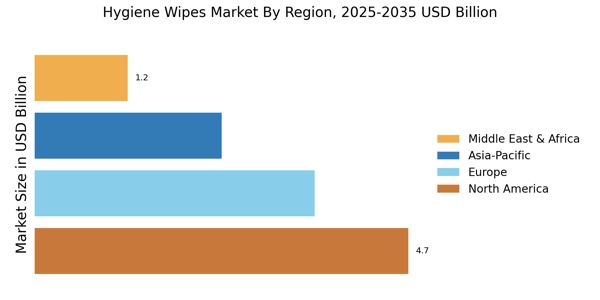Increased Health Awareness
The Hygiene Wipes Market experiences a notable surge in demand due to heightened health awareness among consumers. As individuals become more conscious of hygiene practices, the use of hygiene wipes has expanded beyond traditional applications. The market data indicates that the hygiene wipes segment is projected to grow at a compound annual growth rate of approximately 5.5% over the next five years. This growth is driven by the increasing prevalence of infectious diseases and the rising emphasis on personal cleanliness. Consumers are now more inclined to carry hygiene wipes for on-the-go sanitation, which further propels the market. The Hygiene Wipes Market is thus witnessing a transformation, as products are tailored to meet the evolving needs of health-conscious consumers.
Technological Advancements
Technological advancements are reshaping the Hygiene Wipes Market by enabling the development of more effective and user-friendly products. Innovations in material science have led to the creation of wipes that are not only more absorbent but also infused with advanced cleaning agents. This evolution is reflected in market data, which shows that products featuring enhanced antibacterial properties are gaining traction among consumers. Furthermore, the integration of smart technology, such as moisture-lock packaging, is emerging as a trend within the industry. These advancements not only improve product performance but also cater to the growing demand for multifunctional hygiene solutions. As a result, the Hygiene Wipes Market is poised for continued growth, driven by these technological innovations.
Convenience and Portability
Convenience remains a pivotal driver in the Hygiene Wipes Market. The fast-paced lifestyle of consumers necessitates products that offer ease of use and portability. Hygiene wipes are designed for quick access and immediate application, making them an attractive option for busy individuals. Market data suggests that the demand for travel-sized hygiene wipes has increased significantly, reflecting a shift towards products that cater to on-the-go lifestyles. This trend is particularly evident among urban populations, where time constraints are prevalent. The Hygiene Wipes Market is adapting to these consumer preferences by introducing innovative packaging solutions that enhance portability, thereby expanding its reach and appeal.
Evolving Consumer Preferences
The Hygiene Wipes Market is significantly influenced by evolving consumer preferences, particularly regarding product formulation and efficacy. Consumers are increasingly seeking wipes that are not only effective in cleaning but also safe for their skin and the environment. This shift has led to a rise in demand for biodegradable and hypoallergenic options. Market data indicates that the segment of eco-friendly hygiene wipes is expected to grow by over 7% annually, reflecting a broader trend towards sustainability. As consumers become more discerning, manufacturers in the Hygiene Wipes Market are compelled to innovate and diversify their product offerings to align with these preferences, ensuring they remain competitive.
Regulatory Support and Standards
Regulatory frameworks play a crucial role in shaping the Hygiene Wipes Market. Governments and health organizations are increasingly establishing guidelines that promote the use of hygiene products, particularly in public spaces. This regulatory support not only enhances consumer confidence but also drives market growth. For instance, the introduction of standards for antimicrobial efficacy has led to a surge in demand for compliant products. Market data reveals that regions with stringent hygiene regulations are witnessing faster growth in the hygiene wipes segment. Consequently, manufacturers are investing in compliance and quality assurance to meet these standards, thereby bolstering the Hygiene Wipes Market.


















Leave a Comment